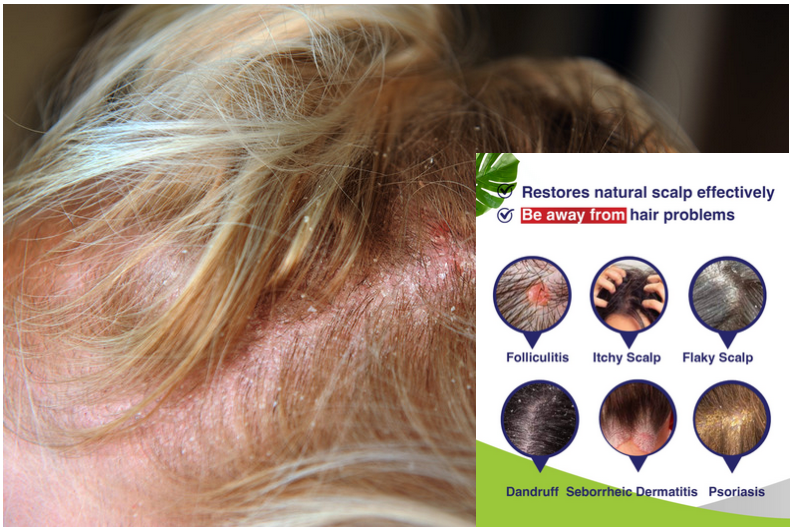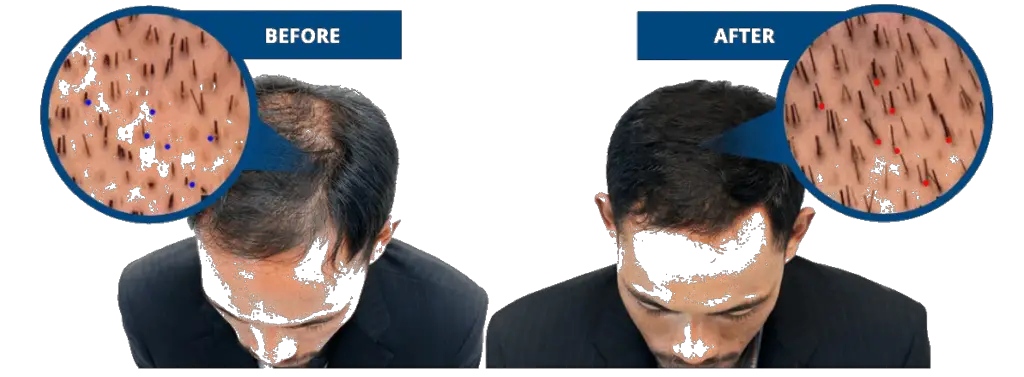Discover effective solutions for managing Hair Loss with Seborrheic Dermatitis. Learn the causes, symptoms, and top treatments to regain a healthy scalp and hair.
If you’re experiencing hair loss and have noticed flaky, red patches on your scalp, you may have seborrheic dermatitis. This common skin condition affects the scalp and other oil-rich areas of the body, causing inflammation and irritation, and can lead to hair loss in some cases. Understanding the relationship between seborrheic dermatitis and hair loss is key to finding the right treatment and regaining healthy hair.
Seborrheic dermatitis is caused by an overgrowth of yeast on the skin, which leads to inflammation and flaking. When this condition affects the scalp, it can cause intense itchiness and irritation, leading to scratching and damage to the hair follicles. This can obstruct natural hair growth and cause hair to fall out. While seborrheic dermatitis doesn’t directly cause hair loss, it can contribute to it by inducing scratching or causing inflammation that interferes with hair growth.
If you’re experiencing hair loss with seborrheic dermatitis, don’t worry – there are treatment options available that can help. In this article, we’ll explore the types of hair loss associated with seborrheic dermatitis, the treatment options available, and how to prevent future hair loss. By understanding the causes of hair loss with seborrheic dermatitis and taking steps to address them, you can regain healthy, luscious locks.
Key Takeaways
- Seborrheic dermatitis can lead to hair loss by inducing scratching or causing inflammation that interferes with hair growth.
- Treatment options for hair loss with seborrheic dermatitis include medicated shampoos, topical creams, and oral medications.
- Prevent future hair loss by avoiding triggers, maintaining good scalp hygiene, and seeking treatment as soon as symptoms appear.
Understanding Seborrheic Dermatitis
If you’re experiencing hair loss, you may be wondering if seborrheic dermatitis is the culprit. Seborrheic dermatitis is a common skin condition that affects the scalp, face, and other oily areas of the body. While it can be uncomfortable and sometimes embarrassing, it does not usually cause hair loss on its own.
However, excessive scratching due to the itchiness caused by seborrheic dermatitis can damage hair follicles, leading to some hair loss. In addition, the extra sebum produced by the skin can create irritation and inflammation on the scalp, leading to intense itchiness. Scratching the scalp can damage the hair follicles, which obstructs natural hair growth and causes hair to fall out.
Seborrheic dermatitis is caused by a combination of factors, including genetics, hormones, and environmental factors. It is more common in people with oily skin and can be triggered by stress, harsh detergents, and certain medications. The condition is not contagious and is not caused by poor hygiene.
Symptoms of seborrheic dermatitis include red, scaly patches on the skin, itching, and flaking. It can be treated with medicated shampoos, topical antifungals, or oral medications. It’s important to follow your doctor’s instructions and use the medication as directed to manage the condition.
In summary, while seborrheic dermatitis doesn’t directly cause hair loss, it can contribute to it by damaging hair follicles due to excessive scratching. If you’re experiencing hair loss, it’s important to consult with your doctor to determine the underlying cause and develop an appropriate treatment plan.
Seborrheic Dermatitis and Hair Loss
Seborrheic dermatitis is a common skin condition that affects the scalp, face, and other parts of the body. It is characterized by red, scaly patches that may be itchy or painful. While seborrheic dermatitis does not typically cause hair loss, excessive scratching and irritation of the scalp can lead to damage to the hair follicles, resulting in hair loss.
Seborrheic dermatitis scalp hair loss can occur when the condition is left untreated or when it is not managed properly. Increased oil production on the scalp can create irritation and inflammation, which can lead to intense itchiness. Scratching the scalp can damage the hair follicles, obstructing natural hair growth and causing hair to fall out.
Seborrheic dermatitis hair thinning is another common symptom of the condition. When the scalp is inflamed and irritated, it can impact the hair growth cycle, leading to thinner hair. Additionally, seborrheic dermatitis can cause hair to become brittle and dry, making it more prone to breakage.
If you are experiencing seborrheic dermatitis hair loss, it is important to seek treatment from a Trichologist or Dermatologist. Treatment options may include medicated shampoos, topical corticosteroids, and antifungal agents. It is also important to avoid scratching the scalp and to keep the scalp clean and moisturized.
In some cases, seborrheic dermatitis hair loss pictures may be helpful in diagnosing the condition. If you notice areas of hair loss on your scalp or other parts of your body, it is important to seek medical attention to determine the underlying cause and develop an appropriate treatment plan.
Types of Hair Loss with Seborrheic Dermatitis
Seborrheic dermatitis is a common skin condition that can cause hair loss in some people. The hair loss associated with seborrheic dermatitis can be temporary or permanent, depending on the severity of the condition. In some cases, the hair loss may be due to the inflammation and irritation caused by the condition, while in others it may be due to the excessive production of oil on the scalp.
Seborrheic Alopecia
Seborrheic alopecia is a type of hair loss that is caused by seborrheic dermatitis. It is characterized by thinning hair and bald patches on the scalp. The hair loss may be temporary or permanent, depending on the severity of the condition. Seborrheic alopecia is more common in men than in women.
Dermatitis Hair Loss
Dermatitis hair loss is another type of hair loss that can be caused by seborrheic dermatitis. It occurs when the inflammation and irritation caused by the condition lead to damage to the hair follicles. This can result in thinning hair and bald patches on the scalp. Dermatitis hair loss can be temporary or permanent, depending on the severity of the condition.
Seborrheic Dermatitis Alopecia
Seborrheic dermatitis alopecia is a type of hair loss that is caused by seborrheic dermatitis. It is characterized by hair loss on the scalp, eyebrows, and eyelashes. The hair loss may be temporary or permanent, depending on the severity of the condition. Seborrheic dermatitis alopecia is more common in women than in men.
Seborrheic Dermatitis Female Hair Loss
Seborrheic dermatitis can also cause hair loss in women. The hair loss may be temporary or permanent, depending on the severity of the condition. In some cases, the hair loss may be due to the inflammation and irritation caused by the condition, while in others it may be due to the excessive production of oil on the scalp. Seborrheic dermatitis female hair loss can be treated with various medications and shampoos that are designed to reduce inflammation and irritation on the scalp.
Treatment Options
If you are experiencing hair loss due to seborrheic dermatitis, there are several treatment options available. The goal of treatment is to manage sebum production and reduce inflammation on the scalp.
Over-the-Counter & Natural Treatments
Over-the-counter and natural treatments can be effective for mild cases of seborrheic dermatitis. Pyrithione zinc, found in some shampoos, can help control the growth of yeast on the scalp and reduce inflammation. Tea tree oil, a natural antifungal and anti-inflammatory agent, can also be helpful in managing symptoms.
Other natural remedies for seborrheic dermatitis hair loss include aloe vera, apple cider vinegar, and coconut oil. These can be applied directly to the scalp to reduce inflammation and soothe irritated skin.
Prescription Medications
If over-the-counter and natural remedies do not provide relief, your healthcare provider may prescribe medication. Prescription-strength corticosteroids, such as hydrocortisone, fluocinolone, clobetasol, and desonide, can be applied directly to the scalp to reduce inflammation and itching.
Antifungal medications, such as ketoconazole, can also be prescribed to manage yeast growth on the scalp. In severe cases of seborrheic dermatitis hair loss, your healthcare provider may recommend systemic medications, such as oral corticosteroids or immunomodulators.
Other Treatment Options
In addition to medication, there are other treatment options available for seborrheic dermatitis hair loss. Light therapy, or phototherapy, can be effective in reducing inflammation and controlling sebum production. Laser therapy, which uses low-level lasers to stimulate hair growth, may also be an option for some people.
Overall, there are several treatment options available for seborrheic dermatitis hair loss. It is important to work with your healthcare provider to determine the best course of treatment for your individual needs. With proper treatment, you can manage your symptoms and promote healthy hair growth.
Recovery and Regrowth
If you have been struggling with hair loss due to seborrheic dermatitis, there is hope for recovery and regrowth. While there is no cure for the condition, there are several steps you can take to manage the symptoms and promote hair growth.
Manage Seborrheic Dermatitis
The first step in recovering from hair loss with seborrheic dermatitis is to manage the condition itself. This involves using medicated shampoos and topical treatments to reduce inflammation and keep the scalp clean. Some common ingredients in these products include ketoconazole, selenium sulfide, and salicylic acid. You can purchase these products over the counter or get a prescription from your doctor.
In addition to medicated treatments, there are several lifestyle changes you can make to manage seborrheic dermatitis. These include:
- Avoiding harsh hair products and styling techniques
- Washing your hair regularly, but not too frequently
- Using a gentle, sulfate-free shampoo and conditioner
- Avoiding hot showers and baths
- Managing stress levels through exercise, meditation, or other techniques
Promote Hair Growth
Once you have managed the seborrheic dermatitis, you can focus on promoting hair growth. While there is no guaranteed way to regrow hair, there are several strategies that may help.
One approach is to use hair growth products that contain ingredients like minoxidil, biotin, and caffeine. These products work by stimulating blood flow to the scalp and promoting hair follicle growth. Another option is to take supplements like vitamin D, iron, and omega-3 fatty acids, which can support healthy hair growth.
In addition to these products, there are several lifestyle changes you can make to promote hair growth. These include:
- Eating a balanced diet with plenty of protein, vitamins, and minerals
- Getting regular exercise to improve circulation and reduce stress
- Avoiding smoking and excessive alcohol consumption
- Getting enough sleep to support overall health and wellness
Be Patient
Finally, it’s important to be patient when recovering from hair loss with seborrheic dermatitis. It can take several months or even years to see significant regrowth, and there is no guarantee that you will regain all of your lost hair. However, with the right treatment and lifestyle changes, you can improve the health of your scalp and encourage healthy hair growth over time.
Community Insights
If you are struggling with hair loss due to seborrheic dermatitis, you are not alone. Many people in the seborrheic dermatitis hair loss reddit community have shared their experiences and insights on managing this condition.
One common theme among the community is the importance of proper scalp hygiene. This includes using gentle shampoos and avoiding harsh chemicals that can further irritate the scalp. Some users recommend using natural remedies such as tea tree oil or apple cider vinegar to soothe the scalp and reduce inflammation.
Another tip from the community is to avoid scratching or picking at the scalp, as this can damage hair follicles and lead to further hair loss. Instead, try using a cool compress or anti-itch cream to relieve the urge to scratch.
Many users have also found success in incorporating a healthy diet and lifestyle into their hair care routine. This includes eating a balanced diet rich in vitamins and minerals, staying hydrated, and reducing stress through exercise or meditation.
It’s important to note that what works for one person may not work for another, and it’s always best to consult with a healthcare professional before trying any new treatments or remedies. However, by listening to the experiences and insights of others in the community, you may be able to find new strategies for managing seborrheic dermatitis-related hair loss.
Prevention Strategies
If you have seborrheic dermatitis and are concerned about hair loss, there are several prevention strategies you can adopt to help mitigate the risk.
One of the most effective things you can do is to keep your scalp clean and healthy. This means washing it regularly with a gentle, pH-balanced shampoo. Avoid using hot water, as it can dry out your scalp and exacerbate your symptoms. Instead, use lukewarm water and massage your scalp gently with your fingertips to help loosen any flakes or crusts.
Another important prevention strategy is to avoid scratching or rubbing your scalp. Scratching can damage your hair follicles and lead to hair loss, while rubbing can cause irritation and inflammation. If you find yourself scratching or rubbing your scalp frequently, try wearing a hat or using a headband to help keep your hands off your head.
In addition to these strategies, there are several other steps you can take to prevent hair loss with seborrheic dermatitis. These include:
- Using a medicated shampoo: If you have moderate to severe seborrheic dermatitis, your doctor may recommend using a medicated DHT blocking shampoo containing ingredients like ketoconazole, selenium sulfide, or zinc pyrithione. These ingredients can help reduce inflammation and control the growth of yeast on your scalp, which can help prevent hair loss.
- Eating a healthy diet: Eating a balanced diet rich in vitamins and minerals can help promote healthy hair growth. Be sure to include plenty of protein, iron, and omega-3 fatty acids in your diet, as these nutrients are essential for healthy hair.
- Managing stress: Stress can exacerbate seborrheic dermatitis and contribute to hair loss. To help manage stress, try practicing relaxation techniques like yoga, meditation, or deep breathing exercises.
By following these prevention strategies, you can help reduce your risk of hair loss with seborrheic dermatitis and promote healthy hair growth. If you have any concerns or questions, be sure to speak with your healthcare provider or a dermatologist.
Conclusion
Dealing with hair loss caused by seborrheic dermatitis can be challenging, but there are a few things you can do to manage the condition and promote hair growth. Remember to always consult with a dermatologist or healthcare provider before starting any treatment.
Here are some key takeaways:
- Seborrheic dermatitis is a common skin condition that can cause hair loss.
- The condition is typically caused by an overgrowth of yeast on the scalp, which can lead to inflammation and irritation.
- Treatment options include medicated shampoos, topical creams, and oral medications.
- In addition to medical treatments, there are some lifestyle changes you can make to manage seborrheic dermatitis and promote hair growth, such as avoiding harsh hair products, eating a healthy diet, and managing stress levels.
- It’s important to be patient and consistent with your treatment plan, as it may take several weeks or months to see results.
Remember that everyone’s experience with seborrheic dermatitis and hair loss is unique, and what works for one person may not work for another. With the help of a healthcare professional and some patience, you can manage the condition and promote healthy hair growth.
Frequently Asked Questions
What are the symptoms of seborrheic alopecia?
Seborrheic alopecia is a type of hair loss that occurs due to seborrheic dermatitis, a skin condition that affects the scalp. Symptoms of seborrheic alopecia include hair thinning, patches of hair loss, and an itchy, red, and scaly scalp.
How can I treat hair loss caused by seborrheic dermatitis?
The best way to treat hair loss caused by seborrheic dermatitis is to address the underlying skin condition. This can be done by using medicated shampoos, such as those containing ketoconazole, salicylic acid, or selenium sulfide. In more severe cases, a dermatologist may prescribe topical or oral medications to help manage the condition.
Is hair loss from seborrheic dermatitis permanent?
Hair loss from seborrheic dermatitis is usually reversible with proper treatment. However, if the condition is left untreated for a long period of time, it can cause permanent damage to the hair follicles, leading to permanent hair loss.
Can cutting my hair help with seborrheic dermatitis?
While cutting your hair may help to reduce the appearance of seborrheic dermatitis, it will not treat the underlying condition. It is important to seek medical treatment to properly manage the condition and prevent further hair loss.
What are the triggers for seborrheic dermatitis on the scalp?
The exact cause of seborrheic dermatitis is unknown, but it is believed to be related to an overgrowth of yeast on the skin. Triggers for seborrheic dermatitis on the scalp include stress, hormonal changes, cold weather, and certain medications.
What is the best shampoo for seborrheic dermatitis hair loss treatment?
There is no one-size-fits-all answer to this question, as the best shampoo for seborrheic dermatitis hair loss treatment will depend on the severity of the condition and individual factors such as hair type and sensitivity. However, some commonly recommended shampoos for seborrheic dermatitis include Nizoral, Head & Shoulders Clinical Strength, and Selsun Blue. It is important to follow the instructions on the shampoo label and to use it consistently for best results.
- AI Powered Bald Filter Online 2024: See Yourself with No Hair! - January 19, 2024
- Harklinikken Bad Reviews 2024: Analyzing Negative Feedbacks - January 18, 2024
- How to Get the Alex Eubank Hair | Step-By-Step Tutorial 2024 - January 18, 2024







